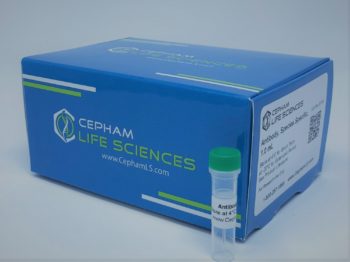Description
Aliases
Bontoxilysin-E, BoNT/E
Antibody Type
Polyclonal Antibody
Species
Clostridium butyricum
Uniprot ID
P30995
Immunogen
Recombinant Clostridium butyricum Botulinum neurotoxin type E protein (2-422AA)
Raised In
Rabbit
Species Reactivity
Clostridium butyricum
Tested Applications
ELISA;Not yet tested in other applications.
Background / Function
Botulinum toxin acts by inhibiting neurotransmitter release. It binds to peripheral neuronal synapses, is internalized and moves by retrograde transport up the axon into the spinal cord where it can move between postsynaptic and presynaptic neurons. It inhibits neurotransmitter release by acting as a zinc endopeptidase.
Isotype
IgG
Conjugate
Unconjugated
Storage Buffer
Preservative: 0.03% Proclin 300
Constituents: 50% Glycerol, 0.01M PBS, PH 7.4
Form
Liquid
Storage
Shipped at 4°C. Upon delivery aliquot and store at -20°C or -80°C. Avoid repeated freeze.
Purity
Caprylic Acid Ammonium Sulfate Precipitation purified
Modification
BoNT/E
Literature
[1]”Neurotoxin type E from Clostridium botulinum and C. butyricum; partial sequence and comparison.” Gimenez J., Foley J., Dasgupta B.R. FASEB J. 2:A1750-A1750(1988). [2]”Cloning of a DNA fragment encoding the 5′-terminus of the botulinum type E toxin gene from Clostridium butyricum strain BL6340.” Fujii N., Kimura K., Murakami T., Indoh T., Tsuzuki K., Yokosawa N., Yashiki T., Oguma K. J. Gen. Microbiol. 137:519-525(1991). [3]”Sequences of the botulinal neurotoxin E derived from Clostridium botulinum type E (strain Beluga) and Clostridium butyricum (strains ATCC 43181 and ATCC 43755).” Poulet S., Hauser D., Quanz M., Niemann H., Popoff M.R. Biochem. Biophys. Res. Commun. 183:107-113(1992).Additional information
| Size | 50μg, 100μg |
|---|


